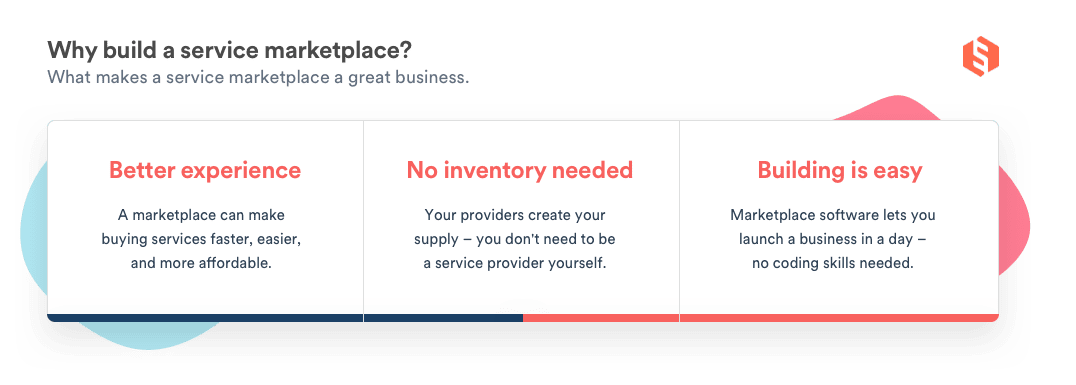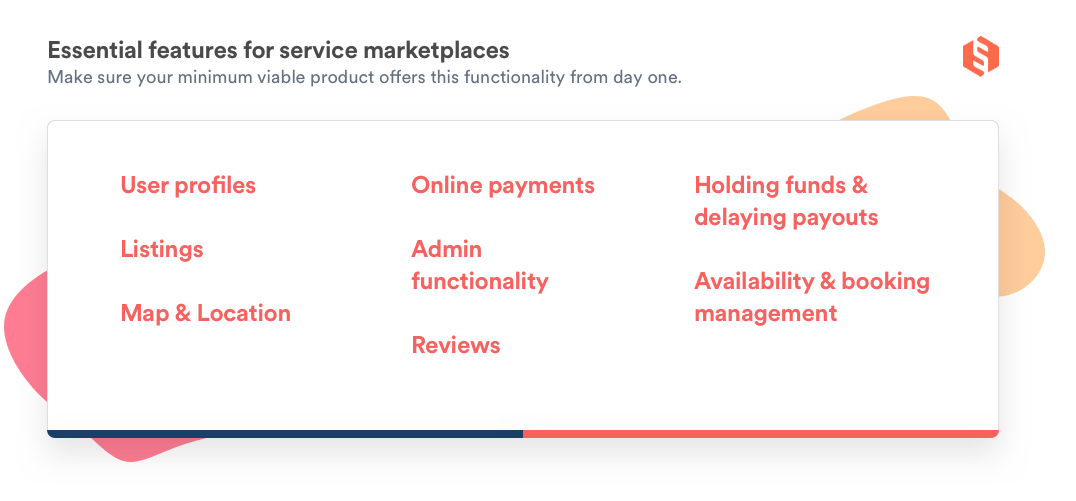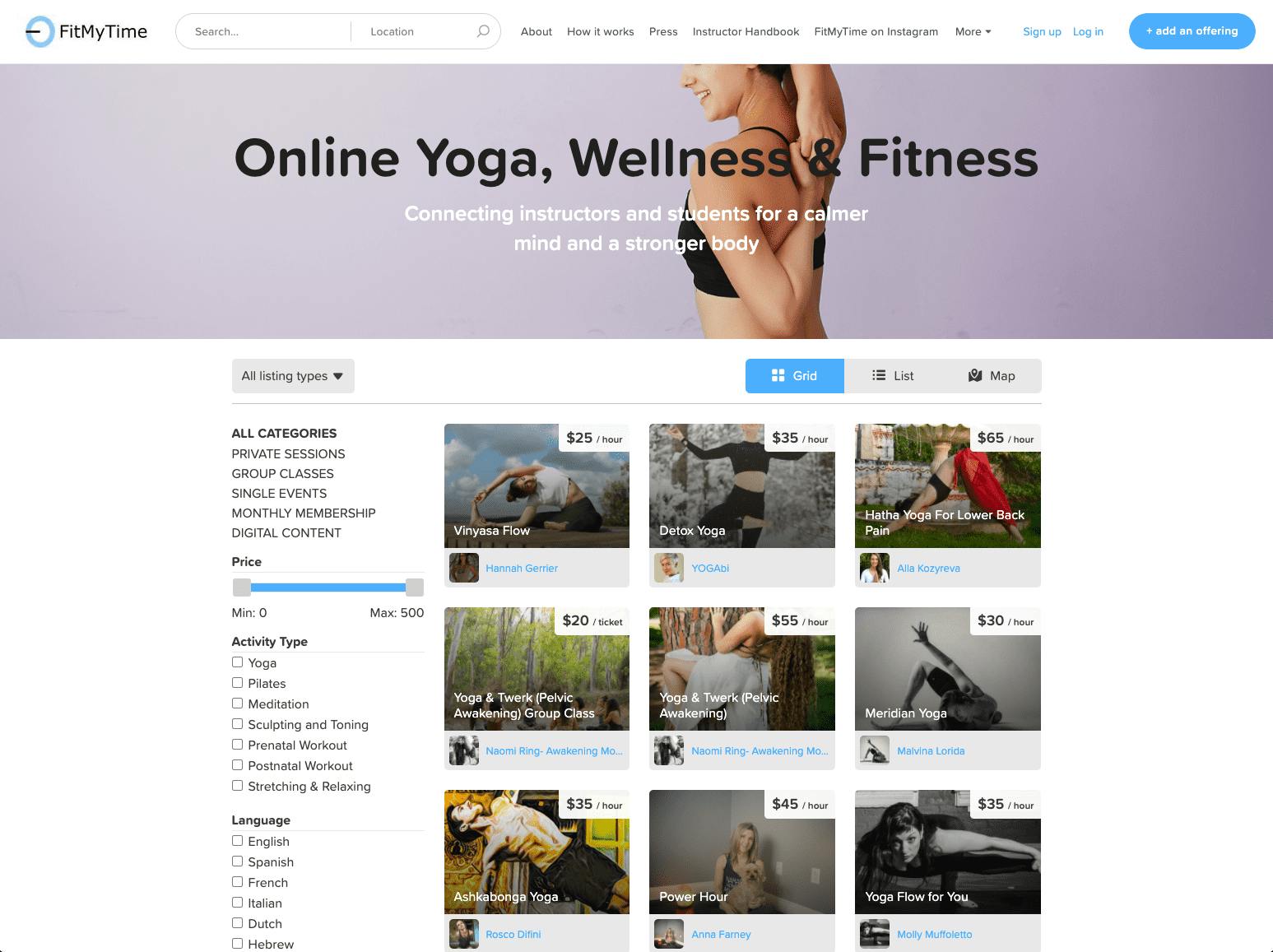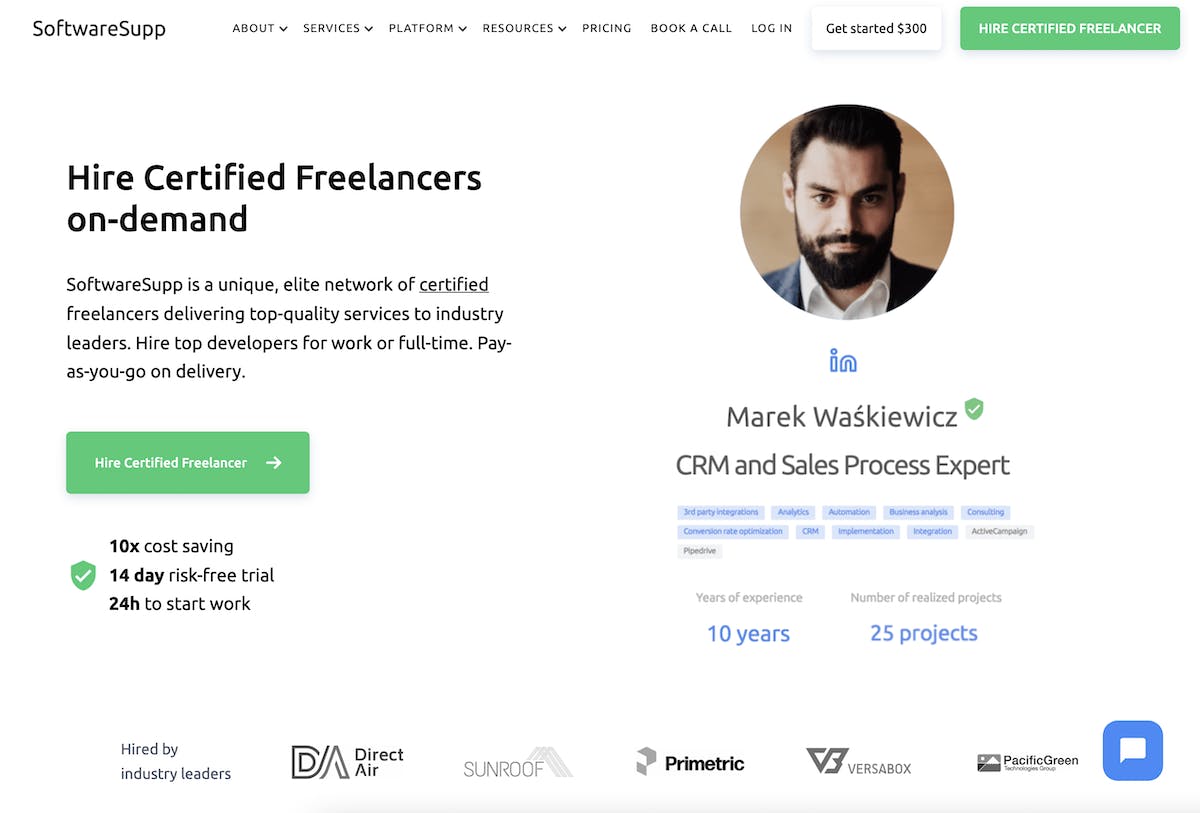How to create a service marketplace
The service sector is massive, and services marketplaces have a huge opportunity in this industry. Here's how you can easily build a service marketplace like Fiverr or Thumbtack.

Table of Contents
Chapter 1
What is an online service marketplace?
An online service marketplace is a website where private individuals, professionals, or companies can offer their services. Examples of services marketplaces are Fiverr, Upwork, and Thumbtack.
Services marketplaces are websites that bring service providers and customers together. They help the two sides find each other and process their transaction through safe online payments.
There are many examples of successful marketplaces that have reshaped entire industries. Uber and Lyft have revolutionized traffic, and Upwork, Thumbtack, and Fiverr have changed how businesses and individuals hire professionals.
Today, the marketplace model is quickly expanding to all types of services. Sharetribe customers have built successful businesses in fields like online learning, e-health, and fitness. (Check out our customer gallery for service marketplace examples.) And established platforms like Upwork are facing competition from specialized players: marketplaces focusing on specific industries or types of professionals.
The service industry, in short, is ripe with marketplace opportunities.
Why build a service marketplace?
Despite the success of a handful of trailblazing services marketplaces, much of the service industry remain undigitized. That's why many investors and experts expect services to be the next big marketplace revolution.
The services sector is massive. In 2022, its contribution to the US GDP is almost $15 trillion. The Covid pandemic brought a big increase in platform use, making digital services a part of everyday life.
Furthermore, marketplaces have huge advantages to bring to the service industry.
Firstly, marketplaces can beat the competition by making buying services a lot faster, easier, more affordable, and more reliable. These four benefits are a key factor behind the successes of businesses like Upwork, Thumbtack, and Urbansitter, and you can leverage them to grow your business, too.

The second big benefit is that you can start a service marketplace without being a professional yourself. Certainly, having a deep understanding of the industry you focus on is extremely helpful. But because service providers create the supply, you can start a business for personal trainers, language teachers, or marketing professionals without having those skills.
Third, building a service marketplace website has never been easier. Nowadays, you can use dedicated marketplace software (like ours at Sharetribe) to build your services platform quickly, easily, and with a low budget.
Building a service marketplace has never been easier.
How the service marketplace business model works
If people use a website to buy services from individuals, professionals, or businesses, how can a service marketplace entrepreneur monetize this behavior?
There are many marketplace business models suitable for service platforms. The most typical ones are commissions, membership or subscription fees, listing fees, lead fees, freemium, and featured listings and ads.
Businesses like Fiverr and Upwork take a cut out of each transaction that happens on their website. This revenue model is called commission, and it’s by far the most popular monetization strategy for marketplaces.

Most importantly, commission is usually the fastest marketplace business model to get your business off the ground. When service providers don’t have to pay anything upfront to sign up, they are much more likely to give your marketplace a try. The biggest challenge, then, is to find the optimal take rate – check out our article on marketplace pricing to learn how.
Some services marketplaces charge a fee from users to join the platform or post a listing. This can be a good strategy if, for example, your customers are so difficult to find that your service providers are ready to pay to access them. Or vice versa.
Some marketplace platforms may also sell ads or additional services. Typically, these strategies are most useful as additional revenue streams on top of commission.
Commission is the fastest business model to get your service marketplace off the ground.
Though commissions can be the best and most scalable revenue model for service marketplaces, it does bring a challenge. Namely, what is to stop people from using your platform to get connected, but then pay each other in private and bypass your commission?
As you’ll find out later, there are many things you can do to prevent platform leakage. One of the most important one is offering the kinds of marketplace features and functionality that make your platform sticky for the service providers.
Chapter 2
How to build a services marketplace – step by step
How to launch your business as fast as possible and learn and improve as you go.
Thanks to marketplace software, developing a marketplace website has become easier than ever before.
But building a platform isn't the hardest thing a marketplace entrepreneur faces. The biggest challenge is solving a real problem for two very different user groups: customers and service providers.
At Sharetribe, we've helped build successful marketplaces for over a decade. Here's a description of a process we find has the highest likelihood of leading to a successful business. We'll look at the process in five steps:
- Find and validate your marketplace idea
- Build a marketplace website MVP
- Ensure support for essential service marketplace features
- Launch and grow your business
- Build–Learn–Improve
Each step has some links to further reading if you're interested in more advice.
Find and validate your marketplace idea
Successful service marketplaces solve a real problem for both user groups extremely well. To compete for the vast opportunities in the industry, your idea should achieve what Thumbtack did: make buying and selling services a lot faster, easier, and cheaper than it previously was.
Try to spot marketplace ideas by analyzing the services you encounter at work or in your free time. Look for
- inefficiencies
- underused assets
- fragmented markets
- services where you can add a layer of trust.
Does it take ages for you to find a repairperson for a specific task?
Is comparing office maintenance providers and asking for quotes so time-consuming that you just use the one you always have?
Would you be willing to pay someone to set up a Google Ads campaign, but find hiring and briefing a stranger too much of a hassle?
When you encounter a hurdle like this, stop and think about how a services marketplace could make the experience smoother.
Look for inefficiencies, underused assets, and fragmented markets. Where could you add a layer of trust?
It’s possible that someone else has come up with the same idea as you have. But don’t shy away from the competition immediately.
For instance, there are many freelance and micro-jobs websites around. But that doesn’t mean you shouldn’t build a website like Fiverr, Upwork, or Thumbtack. A dedicated, niche marketplace might be able to compete with the giants by making finding specific expertise a lot easier.
You could also analyze what people list on generic platforms that aren’t optimized for services. Are lots of professionals trying to offer certain services on Facebook Marketplace? That might mean an opportunity for a service marketplace to improve the experience.
Have an idea in mind? Before building anything, you should validate your marketplace idea by talking to potential users. Try to understand what your assumptions about their problems are, and how well your marketplace idea can solve them. And, importantly: are they willing to pay for the solution your marketplace offers?
Build a marketplace website (start with an MVP)
It’s difficult to predict how people will behave. Your website might offer a specific service a lot cheaper than existing solutions. But is that enough to bring users in? Will they actually make the first transaction? And will they come back and use your marketplace again and again?
The best way to get answers to these questions is to launch your marketplace as quickly as possible.
That way, you can start learning from real users – and making real revenue – early on. The lessons you learn will give you an enormous competitive advantage.
The first version of the service platform you launch doesn't need to be perfect. In fact, we always recommend starting with building a Minimum Viable Product (MVP).
Learning from real users early on is an enormous competitive advantage.
The MVP version of your marketplace should already have the core service marketplace functionality that makes your users love using your website. But nothing more. Anything that isn’t essential is a waste of time and money in the beginning – resources you should use to market your platform, learn from your users, and build your business.
There are many ways to develop a marketplace website. Sharetribe's marketplace software is the fastest way to get started and it has all the essential functionality you need. But if you have some development skills and want to spend more time, it is possible to set up a marketplace with a website builder like WordPress. Developing a marketplace app from scratch takes time and a lot of skill, but if that's something that suits you, here's our guide for this approach.
If you decide to build your site yourself without using marketplace software, it's crucial that you understand the essential features your MVP needs from day one. Next, let’s look at the building blocks of a service marketplace MVP.
Ensure support for the service marketplace essential features
Users expect marketplace platforms to work in a certain way.
Re-inventing the wheel on the most common functionalities can create unnecessary challenges because people might find your use experience difficult.
What is more, online service marketplaces are particularly vulnerable to platform leakage. When a customer and a service provider have met through your website once, what is to stop them from scheduling and paying for all following gigs privately, without paying a penny to you?
When your essential features work seamlessly and intuitively, customers will love using your platform.
When your essential features work seamlessly and intuitively, customers will love using your service marketplace.
And when you offer providers powerful tools to manage their calendars, payment traffic, and their professional brand, they will want to do all their business through your marketplace.
Here are the features service marketplaces will need from day one.
 User accounts and profiles
User accounts and profiles
Both customers and service providers will need to be able to create an account, log in to your marketplace, and store their user information securely. Both sides will also need user profiles.
Profiles are particularly important for service marketplaces because providers are using them to build their professional brands. They likely want to add as much content as possible: descriptions of themselves and their services, photos, testimonials, certificates, and so on.
Both the providers and the customers usually first create a user profile before they do anything else.
 Listings and search
Listings and search
The type of services your platform offers will have a big impact on what kind of listing features you need. In any case, the service providers will want sufficient tools to showcase and market their offering. Users should have powerful tools to browse, search, and filter listings based on their criteria.
The listing and serach functionality on any online marketplace can be complicated to build. However, it’s usually a good idea to limit your offering at the beginning and focus on a core service. Doing this will save you time and help you market your platform to customers.
 Availability & booking management
Availability & booking management
Availability and booking management is a crucial feature for your service providers. It allows them to control when their services are available and also prevents double-bookings. This can signify a huge improvement for your providers’ workflow and convince them to keep their business on your platform.

 Online payments
Online payments
Most marketplaces make money by charging a commission for each transaction that takes place on a marketplace. To be able to do so, quite an elaborate transaction flow is needed.
First, your marketplace needs to allow customers to pay for services with their credit card or Paypal account. Then, you need to be able to pay that money to the right provider, but only after you have deducted your commission. There are all kinds of legal and regulatory questions to take into account, here, as well.
 Holding funds & delaying payouts
Holding funds & delaying payouts
To add a layer of security, you might consider a service called escrow. Escrow means that a customer’s credit card is already charged when they book a service. However, the provider doesn’t get paid the money directly. The platform will instead hold the payment until the service has been delivered.
This arrangement efficiently protects both parties from fraudulent users. Customers can be sure they will either receive the service or get their money back. Service providers are guaranteed the customer will pay as the platform has already charged the customer at the time of booking.
Your marketplace features should help your service providers build their brand.
 Reviews
Reviews
Reviews are an important element of building trust between users. After a successful transaction, the service provider and the customer review each other. This helps both parties feel confident they are dealing with real people with good intentions. Reviews also help build trust for future bookings.
Reviews also help your service professionals build their brand. They can also help prevent platform leakage: a provider might not want to go around your payment system when that also means they won’t get a new customer review to their profile.
 Admin functionality
Admin functionality
The service marketplace entrepreneur needs to have full control over everything that happens on the platform.
Typically, that means you need to have a dashboard where you can monitor and access all user profiles, transactions, messages, and reviews on your marketplace. Firstly, because monitoring how your users behave can give you extremely useful insights particularly in the early days. Secondly, you need to moderate content, block users, and edit payments whenever that’s called for.
 Map & Location
Map & Location
If your marketplace deals with local services like babysitters or photographers, it’s a good idea to allow the service provider mark their location on their listings, and the customer to search for listings based on location.
However, if your marketplace focuses only on digital or remote services, you might not need a location feature at all. A customer who buys website development or virtual yoga classes, for instance, doesn’t need to care about where the service provider is located. For these kinds of marketplaces, an unnecessary map feature might even feel a bit confusing.
Launch and grow your business
After your service marketplace MVP is ready, it's time to launch it to your audience. Or audiences to be precise, because marketplaces serve two very different user groups: service providers and customers.
In most cases, the best way to start building your user base is by bringing the service providers in first. That way, you'll have something to show to the very first customers who land on your site. Service providers usually have an incentive to join your marketplace because it will help them reach more customers.
And, if your essential features have been built well, you can show your first service providers how your tools help them manage their payments and bookings.
We recommend that you don't do a big marketing launch for your marketplace before you have a high-quality supply in place. And even then, it could be a good idea to divide your marketplace launch into two parts: a product launch and a marketing launch.
Start building your user base by bringing the service providers in first.
Your early work on building a user base is also the foundation of your marketplace growth strategy. The key to growing your service marketplace is to reach a virtuous cycle: high-quality providers bring in more customers, and the growing customer base, in turn, attracts more providers.
Reaching this virtuous cycle usually takes some trial and error. Start by brainstorming growth ideas (e.g. content marketing, SEO, social engagement, PR, influencer marketing, paid ads, sponsorships, and so on), choose the most promising ones, and run quick tests on them. See if the strategies move the needle, adjust accordingly, and keep iterating on your growth engine.
Remember, too, to track your key marketplace metrics from day one. Knowing how to measure success will lay a solid foundation for growing your service business in the long term.
Build–Learn–Improve
Getting your idea out into the world as quickly as possible is the first step towards success.
But as your service marketplace grows, you’ll likely learn your particular users would appreciate additional, more tailored functionality. This kind of insight is near-impossible to get beforehand—the best way to understand what your users are like is to offer them something to use and ask for their feedback.
Once you know more about your users, adding powerful, customized features to suit their needs can be a powerful way to boost customer lifetime, prevent platform leakage, and grow your business. Embracing the process of building, learning, and improving will help you make strategic decisions that grow your brand, platform, and user base in the right direction.

Sharetribe’s products are developed with this iterative process in mind, with a specific focus on service and rental marketplaces.
Sharetribe Go gives you all the essential features listed above, so you can have a professional service marketplace up and running in one day. You don’t need to write a single line of code or worry about hosting, maintenance, security, or backups.
Once you’re ready to take your business to the next level, you can move your platform to Sharetribe Flex. Like Go, Flex offers all the essential service marketplace functionality out of the box. It also includes backend hosting, maintenance, security, backups, and updates. Meanwhile, Flex’s API-based, headless architecture lets you code your own front end, custom-build additional features, and build third-party integrations. It's a solution that combines the freedom and flexibility of custom development with the benefits of software-as-a-service.
Chapter 3
How much does it cost to build a service marketplace?
Building a marketplace website can be a time-consuming and expensive project and require lots of technical knowledge. Luckily, there are easier and cheaper ways.
Services marketplaces are complicated websites. Even the MVP version requires lots of features for both user groups, not to mention a powerful transaction engine and admin functionality.
Building such a site from scratch—and making sure it works extremely smoothly so users love using it—is time-consuming and expensive. Developer’s hourly fees vary greatly, but typically, $50,000 is the minimum for a basic service marketplace feature set. Fees from hosting, third-party tools, maintenance, and updates come on top.
The most important resource a marketplace founder has is their time.
If you're comfortable with software programming, you can naturally avoid the building cost. However, you should assign a monetary value to your own work. The most important resources founders have are their time and focus – be sure to spend them where they offer the biggest return on investment.
If you're interested in exploring this option further, I recommend checking out this article on developing a marketplace app by our senior full-stack developer Mikko. It helps you estimate the scope of the project and choose your technology stack. If you'd like to compare different approaches, this article on different ways to develop a marketplace be helpful.
Our goal with Sharetribe is to offer marketplace products that help founders build a marketplace at a fraction of the cost of custom development. Here's a breakdown of an example budget for the first year using both our products, Go and Flex.
Your service platform
| Pro subscription of Sharetribe Go for 12 months (semiannual billing) | $1,428 |
| Domain registration for 12 months | $10 |
| Logo design – free using a tool like Canva | $0 |
| Stock images – free using a service like Unsplash | $0 |
Marketing & user acquisition
| Wordpress blog | $100 |
| MailChimp email marketing – free up to 2,000 subscribers | $0 |
| Google Analytics – free version | $0 |
| Total 1st year service marketplace budget with Sharetribe Go | $1,538 |
On top of this budget, you might want to consider buying traffic in the form of Google Ads, for instance. However, getting a meaningful amount of traffic through paid advertising typically requires being prepared to spend at least around $1,000 for relevant keywords per year.
Sharetribe Go is free to try for 30 days, you can start your trial here.
Your service platform
| Sharetribe Flex subscription for 12 months (annual billing) | $3,588 |
| Sharetribe Flex transaction fee – $0 up to $30,000 in monthly transaction volume | $0 |
| UX design and wireframes | $1,500 |
| Flex development | $5,000 |
| Front-end hosting | $360 |
Marketing & user acquisition
| Wordpress blog | $300 |
| MailChimp Standard plan for up to 25,000 subscribers | $2,628 |
| Google Analytics – free version | $0 |
| Total 1st year service marketplace budget with Sharetribe Flex | $13,376 |
At this stage, you likely know your market and customer lifetime value well enough that investing in paid acquisition channels as part of your marketing mix might make sense.
Developing with Flex is free for an unlimited time. That means the monthly fee doesn't start applying until you are ready to launch your marketplace. You can create your Flex account and start developing for free here. If you don't have a developer in your team, Sharetribe is happy to match you with a verified Flex Expert. Learn more about custom development services for Sharetribe Flex.

FitMyTime
FitMyTime is a platform for private online yoga, pilates, and fitness classes. Built with Sharetribe Go.

Paperound
Paperound is an hourly intern resource for startup founders. Built with Sharetribe Go.

SoftwareSupp
SoftwareSupp is a marketplace for hiring a freelancers for software projects. Built with Sharetribe Flex.
Chapter 4
Get started with your online service marketplace today
Start working on your idea one step at a time.
Building a service marketplace can sound like a daunting task. Today's users are familiar and comfortable with eCommerce, but at the same time, they expect a flawless user experience. Service marketplaces are complicated websites to build, and the business model can be tough to master.
Don't let the challenge discourage you.
By taking the iterative approach and moving your business idea forward one step at a time, you'll accumulate experience and understanding that give you a real competitive advantage. If you're interested in reading more, our How to start a marketplace guide is a great place to start working on your business step by step (regardless of whether you're building your marketplace website with Sharetribe or not.
Best of luck with your service marketplace!